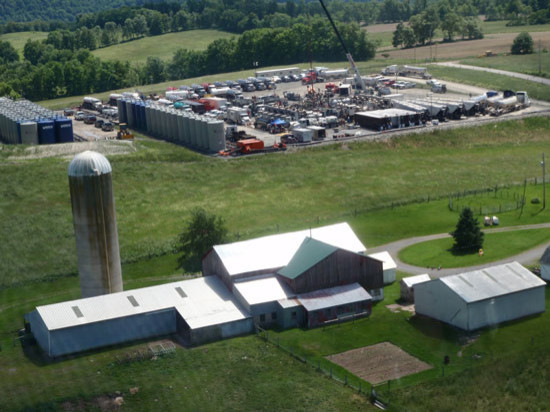Fracking Safety Debate: Methane Contamination Found In Water Near Shale Gas Wells In Pennsylvania

A new scientific study suggests that stray gases are contaminating drinking water in homes near shale gas wells in Pennsylvania’s Marcellus basin, though drilling advocates are quick to point to other research showing naturally occurring gas seepage.
Researchers from Duke University, the University of Rochester and California State Polytechnic University analyzed 141 drinking-water wells in northeastern Pennsylvania’s Marcellus Shale, expanding upon a previous study published in 2011. They found methane in 82 percent of the water samples. In samples taken within 1 kilometer of natural gas wells, methane concentrations were six times higher on average than water from wells farther away.
Methane, the chief component of natural gas, is odorless and nontoxic but extremely flammable. Researchers also found higher concentrations of ethane and propane -- byproducts of natural gas processing -- in water taken from homes closer to shale gas wells. The study was published on Monday in the Proceedings of the National Academy of Sciences.
"The methane, ethane and propane data, and new evidence from hydrocarbon and helium isotopes, all suggest that drilling has affected some homeowners' water," lead author and Duke environmental scientist Robert B. Jackson said in a statement. "In a minority of cases, the gas even looks Marcellus-like, probably caused by faulty well construction."
However, other studies show that methane can be found in Pennsylvania drinking water regardless of proximity to gas drilling. Last week, the U.S. Geological Survey announced that its scientists had found naturally occurring methane in two of 20 randomly selected household wells that are not near any existing drilling operations in the Marcellus Shale. Industry advocates say the USGS study casts some doubt on whether or not the contamination found by the Duke-led group can really be connected to drilling.
“The [Duke] researchers found methane in virtually every water well they sampled, irrespective of proximity to Marcellus development,” John Krohn, a spokesperson for the industry-backed group Energy In Depth, wrote in an email. “However, they seemingly downplay this finding by seeking a ‘simple’ explanation for methane’s presence.”
Fred Baldassare, a former researcher with the Pennsylvania Department of Environmental Protection who now consults for the oil and gas industry, also took issue with the study’s design. Baldassare told the Associated Press that rather than doing a random sampling of wells, the Duke team collected data in areas where people had already complained about possible drilling contamination.
Another contamination concern associated with natural gas drilling is that fracking fluid -- a mix of water, sand and chemicals -- will seep into groundwater near drilling sites. But neither the current study nor two previous studies by Duke scientists have found clear evidence of fracking fluid contamination.
Nevertheless, "our studies demonstrate that distances from drilling sites, as well as variations in local and regional geology, play major roles in determining the possible risk of groundwater impacts from shale gas development,” Duke researcher Avner Vengosh said in a statement. "As such, they must be taken into consideration before drilling begins."
Pennsylvania is one of two states in the U.S. that does not set statewide standards for construction of private water wells. And water wells in rural parts of the state had existing water-quality issues unrelated to drilling. Of 233 water wells tested in a March 2012 Pennsylvania State University report, 40 percent failed at least one safe drinking water standard (most commonly, bacterial contamination).
SOURCE: Jackson et al. “Increased stray gas abundance in a subset of drinking water wells near Marcellus shale gas extraction.” PNAS published online 24 June 2013.
© Copyright IBTimes 2024. All rights reserved.





















